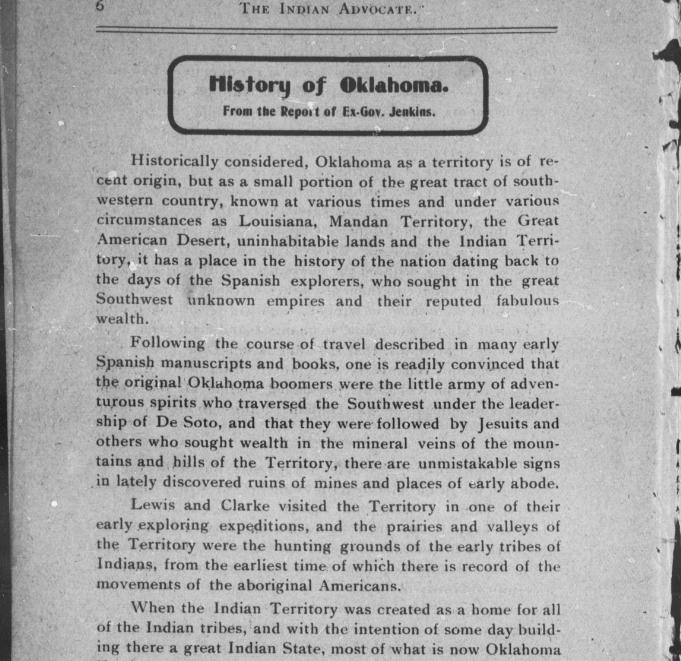|
Moderated by NW Okie! |
Volume 14 , Issue 352012Weekly eZine: (374 subscribers)Subscribe | Unsubscribe Using Desktop... |
History of Oklahoma

In The Indian Advocate, dated 1 January 1902, page 6, there was a bit of mention of "History of Oklahoma" as taken from the report of ex-governor Jenkins.
This is the story of the creation of Oklahoma Territory, but of the long struggles to secure the various enactments of Congress required to bring it about, of the successive great rushes of settlers to the country, of the Struggles to build up here an ideal American commonwealth, and of the great measure of success attained, volumes might be written.
Historically, Oklahoma as a territory was of recent origin, but was a small portion of the great tract of southwestern country, known at various times and under various circumstances as Louisiana, Mandan Territory, the Great American Desert, uninhabitable lands and the Indian Territory, it had a place in the history of the nation dating back to the days of the Spanish explorers, who sought in the great Southwest unknown empires and their reputed fabulous wealth.
It was described in many early Spanish manuscripts and books back in 1902, that the original Oklahoma boomers were the little army of adventurous spirits who traversed the Southwest under the leadership of DeSoto, and that they were followed by Jesuits and others who sought wealth in the mineral veins of the mountains and hl's of the Territory, there are unmistakable signs in lately discovered ruins of mines and places of early adobe.
lewis and Clarke visited the Territory in one of their early exploring expeditions, and the prairies and valleys of the Territory were the hunting grounds of the early tribes of Indians, from the earliest time of which there is record of the movements of the aboriginal Americans.
The Indian Territory was created as a home for all of the Indian tribes, and with the intention of some day building there a great Indian State, most of what was Oklahoma Territory was included within its bounds, and Washington Irving, who, in 1834, made a hunting trip here, described most graphically the beauty and wealth of Oklahoma's natural endowments in his sketch, "A Tour of the Prairies."
It was some time early in the 1870's the name of Oklahoma first appeared in political history, with the occasion being the introduction in Congress of a bill to create a territory out of a portion of the Indian Territory to be known as Oklahoma. The measure failed of passage, and for more than a decade little or nothing was heard of this country.
There was an agitation started by Payne and Couch and kept up by their intrepid little band of Boomers until, in March, 1889, in the dying hours of Congress, an amendment was tacked on the Indian appropriation bill providing for the opening to homestead settlement of the little area of land then known as Oklahoma, embracing less than 3,000,000 acres now lying in the heart of a great Territory.
this land was opened on April 22, 1889, and then occurred the first great Oklahoma rush. The brief legislation opening the land provided no form of government, and for over a year the people of the territory were a law unto themselves. The only government during this period was that created and maintained by common consent, yet there was no lawlessness or outlawry, and property and life were adequately protected at all times.
In June, 1890, the territorial government came into existence, and by the same act of Congress the strip of country known as "No Man's Land," embracing 3,681,000 acres, was added as Beaver county. In September of the same year the 1,282,434 acres embraced in the Sauk and Fox, Iowa and Pottawatomie reservations, in the eastern part of the Territory, were opened to settlement, and the following spring came the 4,297,771 acres of Cheyenne and Arapaho land. September 16, 1893, the Cherokee strip was opened to settlement, and the counties of Kay, Grant, Woods, Woodward, Garfield, Noble and pawnee created from its 6,014,239 acres of fertile land. In 1895 the Kickapoo reservation of 206,662 acres was settled, and the year following Greer county, which had been previous to that considered a portion of Texas, was given to the Territory by a decision of the Supreme Court of the United States.
All these, with the Kiowa, Comanche and Apache and Wichita Indian reservations just opened, give the Territory a settled area of 24,000,000 acres, 1,725,646 still being included in Indian reservations.
In the little more than a decade which had elapsed since the creation of the Territory, the people had accomplished here more than any other community had ever accomplished in a quarter of a century. The story of the achievements of this people, whose progressiveness, energy, industry and American citizenship has never been equaled, reads almost like a fairy tale, and the great and lasting results attained can only be realized by him who comes and views and ponders.
| View or Add Comments (0 Comments)
| Receive
updates ( subscribers) |
Unsubscribe
| © . Linda Mcgill Wagner - began © 1999 Contact Me | |
